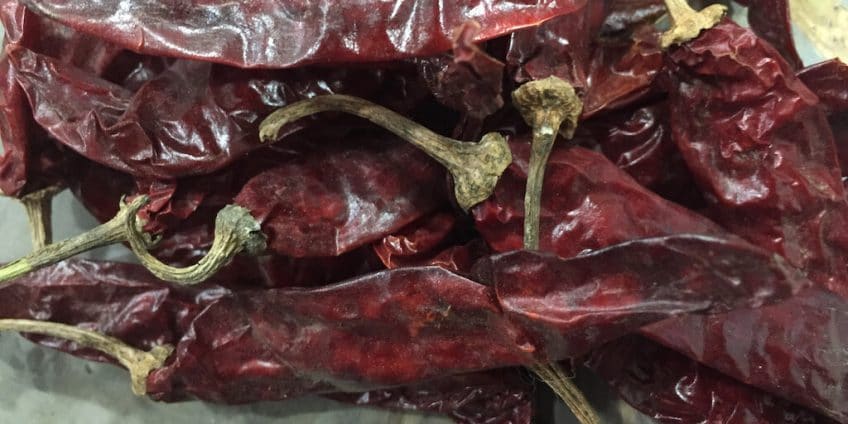Scroll to Recipes with Chili Pepper / लाल मिर्च as ingredient
Chilli pepper is believed to originate in Mexico. It is cultivated mainly in America and some parts of Europe.
In today’s time, India is the world’s largest producer, consumer, and exporter of chili. Dried chili exports make up 22% of all the spices exported from India.
Though there is a wide variety of chili, there are four types of chili commonly used in India. They are -Lal Mirch, Hari Mirch, Degi Mirch (Paprika), and Shimla Mirch (Sweet bell pepper).
Nomenclature
Here is a table of common names for chili.
| Language | Name | Written as |
|---|---|---|
| Bengali | Laṅkā | লঙ্কা |
| Gujarati | Marcha | મરચાં |
| Hindi | Mirch | मिर्च |
| Kannada | Meṇasinakāyi | ಮೆಣಸಿನಕಾಯಿ |
| Malayalam | muḷak | മുളക് |
| Marathi | Mirchi | मिरची |
| Tamil | Miḷakāy | மிளகாய் |
| Telugu | Mirapa | మిరప |
| Urdu | Mirch | مرچ |
| Punjabi | Miraca | ਮਿਰਚ |
| Sanskrit | vistambhin, jadya | विष्टम्भिन्, |
Mineral and Vitamins
Here are some of the common minerals and vitamins found in chili pepper.
Vitamin A
Vitamin A is found in an abundant amount in red chili pepper, which can assist in keeping-off bacterial and viral infections. Alongside it, prevent night blindness, and keep your hair and nails healthy.
Vitamin B
Chilli possesses Vitamin B6, which helps support metabolism.
Vitamin C
Vitamin C is found in chili. Chilies are natural antioxidants to help protect the health of your cells, improves your body’s iron absorption, essential for promoting healthy teeth and gums, healing wounds, and helping you resist infection.
Vitamin E
Chilies are an excellent source of Vitamin E. Vitamin E is a powerful antioxidant. It helps protects your cells from damage. It also helps your body using vitamin K and repair muscle cells.
Vitamin K
Chili is a rich source of Vitamin K. Without Vitamin K; one can bleed to death from a minor cut as the blood will not clot. Vitamin K can help maintain bone strength in aged people.
Copper
Chilies are an excellent source of copper, which is an essential trace element, necessary for strong bones and healthy neurons.
Potassium
Another mineral found in chili is potassium that may reduce your risk of heart disease when consumed in adequate amounts.
Source: ncbi.nlm.nih.gov
Benefits of Chilli
Chilies are not just important for their burning taste, but also their health benefits too.
Pain relief
Capsaicin, the most bioactive plant compound in chili peppers, has some unique properties. It binds with pain receptors that sense pain. It induces a burning sensation but doesn’t cause any real burning injuries.
Weight loss
Chili peppers consist of capsaicin, which could have benefits for weight loss. A 2012 systematic review, published within the journal Appetite, shows that capsaicin may increase fat burning and reduce appetite
Source: ncbi.nlm.nih.gov
Improves Digestive Health and Metabolism
One of the essential advantages of capsaicin is its contribution to gut health and weight loss. It can accelerate your metabolism. When your metabolism is accelerated, it improves the rate at which fat is burn-in your body.
Source: Lybrate.com
Reduces Cancer Risk
Various studies suggest chili can reduce the danger of colon cancer. Chilies like red pepper have carotenoid lycopene, which prevents cancer disease.
Source: experimentalbiology.org
Fights Fungal Infections, Colds, and the Flu
Vitamin A and vitamin C, present in the chili peppers, are vital in building up your immunity against infections and illnesses. If you are suffering from a high fever, hot chili peppers can stimulate the immune system to fight off the virus.
Fights Inflammation
Consumption of chili can block Substance P, which is associated with inflammatory processes.
Source: experimentalbiology.org
Decrease Risks of Type 2 Diabetes
Chili peppers can reduce the danger of developing higher glucose levels in the blood, which is a common symptom for Type 2 Diabetes.
Helps formation of Red Blood Cells Growth
Chili peppers can cause the formation of new blood cells as they are rich in copper and iron. As such, they are ready to treat symptoms of anemia and fatigue.
Mood Booster
Chilli peppers contain capsaicin, which alleviates the feeling of pain and encourages the release of endorphins, our body’s natural “happy “ pills.
When eaten, green chilies releases endorphins that can help boost the mood.
Source: c3a.org.sg
Frequently Asked Questions about Chili
How much sunlight do chili plants need?
Chili can grow in semi-shade, but it won’t produce many fruits as they thrive on sunlight. So it is beneficial to keep them in daylight. Chilies are dried in sunlight to be able to store for an elongated period.
What makes the chili hot?
The active chemical Capsaicinoids present in chili makes it hot.
Do chilies contain vitamins?
Chili contains a high amount of vitamin A, C, and is rich in Vitamin E and K.
Which is the world’s hottest chili?
According to experts at the defense research laboratory within the army garrison, the hottest chili is from Tezpur within the north-eastern state of Assam in India.
Why do we like to eat chili?
When nerve cells release substance, the body produces chemicals called endorphins – and it similarly acts on brain cells like morphine. As a result, when we eat chili, it elevates the mood and increases the feel-good factor.
What causes the burning sensation in chili?
The main compound capsaicin present in chili is the cause of the burning sensation.
Which country is the largest producer of chili?
India ranks as the top producer of chilies in the world. It produces approximately 1.1 million tonnes annually.

